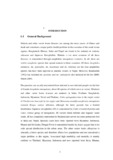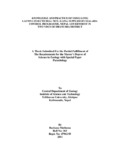Please use this identifier to cite or link to this item:
https://elibrary.tucl.edu.np/handle/123456789/3573Full metadata record
| DC Field | Value | Language |
|---|---|---|
| dc.contributor.author | Mathema, Rachana | - |
| dc.date.accessioned | 2021-07-28T04:28:04Z | - |
| dc.date.available | 2021-07-28T04:28:04Z | - |
| dc.date.issued | 2011 | - |
| dc.identifier.uri | http://elibrary.tucl.edu.np/handle/123456789/3573 | - |
| dc.description.abstract | The study was carried out in two VDCs of Dhanusa district from March to September 2010 with the main objective to explore the knowledge of the people about medicated (insecticidal) nets provided free by the Malaria Control Programme, Epidemiology and Disease Control Division (EDCD), Nepal Government to these two VDCs which falls in the malarious belt of Dhanusa district. Malaria has become one of the world's most important public health concerns. It is the disease caused by protozoan parasite belonging to the genus Plasmodium. Two hundred families in Naktajhij village and one hundred eighty families in Dhalekbar village of the district were taken as the respondents in the study. In Naktajhij (199/200) i.e. 99.5% families and in Dhalkebar (138/180) i.e. 76.7% families received LLIN in the year 2009. People of both villages are interested to use the net as preventive measure to avert from mosquito borne disease. People seemed to be more interested to get net than use and maintain the net properly probably being free distribution. Regarding use and maintenance of LLINs 58.3% (116/199) families in Naktajhij and 58.7% (81/138) families in Dhalekbar have known to use and maintain the net and 41.7% (83/199) families in Naktajhij and 41.3% (57/138) families in Dhalekbar have not known to use and maintain the net properly. With regarding effectiveness of LLIN after washing, 78% (141/181), 15.5% (28/181), 4.9% (9/181) and 1.6% (3/181) respondents in Naktajhij and 60.3% (73/121), 29% (35/121) and 10.7% (13/121) respondents in Dhalkebar replied that the effectiveness of net was lost after washing once, twice, thrice and four times respectively. In Naktajhij, 55% (109/199) families and in Dhalkebar 72% (99/138) families informed that people found dead mosquitos and other insects after the use of net. Regarding satisfaction of LLIN Distribution 42.2% (84/199) families in Naktajhij village and 31.9% (44/138) families in Dhalekbar village were satisfied and 57.8% (115/199) families in Naktajhij village and 68.1% (94/138) families in Dhalekbar village were unsatisfied .In Naktajhij, 76.9% (153/199) families and in Dhalkebar, 56.5% (78/138) families also complained about the side effects they faced after the use of the net. Medicated net perceived as simple, economical and less costly and durable means to protect people from mosquito bites and its effects. | en_US |
| dc.language.iso | en_US | en_US |
| dc.publisher | Central Department of Zoology | en_US |
| dc.subject | Health concerns | en_US |
| dc.subject | Epidemiology | en_US |
| dc.title | Knowledge and Practice of Using Long Lasting Insecticidal Nets (Llins) Supplied by Malaria Control Programme, Nepal Government in Two VDCS Of Dhanusha District | en_US |
| dc.type | Thesis | en_US |
| local.institute.title | Central Department of Zoology | en_US |
| local.academic.level | Masters | en_US |
| Appears in Collections: | Zoology | |
Files in This Item:
| File | Description | Size | Format | |
|---|---|---|---|---|
| Chapter.pdf | 424.56 kB | Adobe PDF |  View/Open | |
| Cover.pdf | 167.82 kB | Adobe PDF |  View/Open |
Items in DSpace are protected by copyright, with all rights reserved, unless otherwise indicated.
